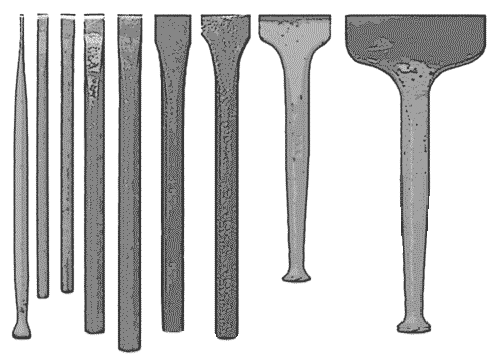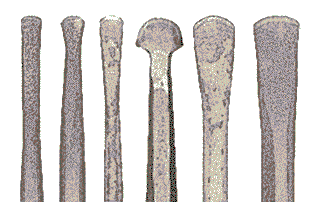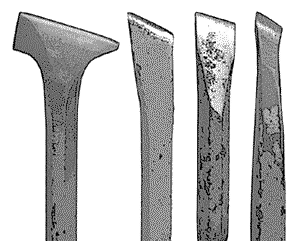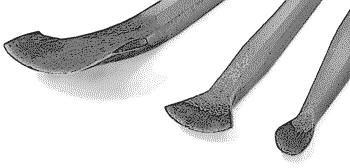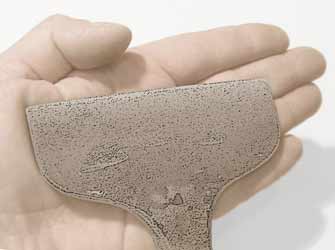 | ||||
 | ||||
home / about the artist / stoneboat series / lipwork series / metaphorical presences / landscapes / multi-element installation pieces / recent works
technical processes / thumbnail galleries / Cortona foundry / Finland stone carving / recommended reading / all in the family / links page
www.dondougan.com
DON DOUGAN
HAND CARVING CHISELS
TRADITIONAL PROCESSES
The Flat Chisel is primarily used to follow and refine the work of the toothed chisel. It is used to flatten surfaces, to crisp-up edges and intersections of planes, and to incise lettering.
 | ||||
 | ||||
 | ||||
 | ||||
CHISELS WITH SHARP EDGES
 | ||||
The Rondel, Round, or Bullnose Chisel is used in much the same manner as the Flat Chisel except it is used for flattening concave surfaces and working into intersections of curved planes. The curved corners of the Rondel allow curved hollows to be worked without marring the adjacent surfaces.
The Gouge is used in much the same manner as the Rondel, though allowing a greater
control over the uniformity of the cut.
The Gouge is used primarily when working softer stones or when doing architectural carving of moldings, when its contoured cutting edge can be more effectively used to achieve uniformity.
The Skew, Miter, or Angle Chisel
Because its cutting edge is ground at an oblique angle to the shank rather than the perpendicular of the common Flat Chisel, the Skew Chisel is better suited for working into interior intersections of flat planes, such as the interior of boxlike recesses or channels. The oblique cutting edge allows the tool to be worked from several angles of attack, which is especially useful in deeper recesses that are difficult to work in the single angle provided by the common Flat Chisel.
Though the Flat Chisel can be used to carve the form to shape, perhaps its best employment is to remove any toolmarks remaining on the surface from from the previous chisels, including any ‘bruises’ below the surface.
To accomplish this refining action the cutting edge of all the types of Flat Chisel needs to be kept sharp so they can cut cleanly - removing small particles with more of a shaving action rather than breaking or chipping-off chunks. Using a smaller hammer or a mallet allows greater control when working with a sharp-edged chisel.
The Inverted Rondel is useful when forming ribbing or working a regularly raised ridge.
The Angle Chisel is used primarily by carvers doing architectural or monument work, so is found through tool suppliers that serve those trades primarily, rather than suppliers of tools for purely sculptural endeavors.
 | ||||
The Cape Chisel — also called a Splitter — has a narrow blade (1/8-inch to 3/8-inch wide) that swells and thickens in the opposite dimension about one inch away from the cutting end of the chisel. This extra steel strengthens the cutting end of the relatively narrow tool and allows it to be struck with fairly powerful blows without damaging the tool. It is used for cutting narrow grooves or hollows into the surface.
Another type of narrow flat chisel is the Lettering Chisel. It is available in the same widths but does not have any swelling near the cutting edge, and is usually delicately ground and sharpened to a acute angle.
 | ||||
The Bolster or Drove, a Flat Chisel that is two-inches wide or more, is used when working broad, flat areas. The picture at left shows a very wide hand-forged example.
